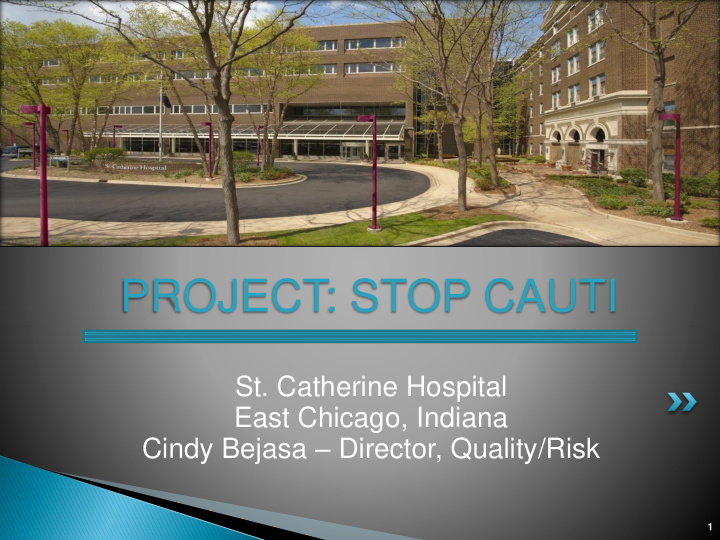



PROJECT: STOP CAUTI St. Catherine Hospital East Chicago, Indiana Cindy Bejasa – Director, Quality/Risk 1
Nonprofit, full service hospital, deeply committed to serving the poor and under-served: • Safety-Net/Disproportionate Share Hospital, with approximately 30% Medicaid and 4% Self Pay Inpatient and outpatient care - all medical specialties: • Emergency, Critical Care, Med-Surgical, Maternal & Child, NeuroBehavioral Medicine, Surgical Services 2
• Hospital and Stroke Program are accredited by The Joint Commission • Chest Pain Program is certified by the Society of Cardiovascular Patient Care • Acute Rehabilitation Unit accredited by CARF • Laboratory accredited by CAP 3
4
Analyze the data/understand the requirements • Two to three years worth of data; identify trends Set improvement priorities • Set goals and expectations, benchmark with best practice Identify and implement targeted interventions • Implement evidence-based practice guideline Engage the team • Physicians and front line staff Measure and monitor success • Communicate to all departments 5
6
Director of Education Charge Nurse, Surgical Services Staff Nurse, Medical – Surgical Floor Purdue students Infection Control Committee Physician champions: urology, infection disease 7
Reduce rate/number of CAUTI’s by 40% by end of December, 2013 8
Urinary tract infection causes 40% of hospital acquired infections Most infections are due to urinary catheters Leads to increased morbidity and cost Reducing CAUTI not only will reduce cost of healthcare but will also improve patient safety 9
1. Catheter Placement 4. Catheter 2. Catheter Care Replacement 3. Catheter Removal 10
Make sure the catheter is indicated Adhere to evidence – based practice guidelines endorsed by CDC • Aseptic insertion, proper maintenance, hand hygiene, use of chlorhexidene, etc Remove the catheter as soon as possible 11
Required documentation of indications prior to insertion of indwelling catheter Implemented the prevention bundles/strategies endorsed by CDC Implemented the nurse driven protocol for removal • Assessment of indwelling catheter for appropriate use and removal 12
13
14
15
16
Per ercent cent of Re Results ts Measuremen urement Baseline ine Reduct ction ion CY 2013 CAUTI Rate/1000 Foley Days 2.60 1.50 42% Number of CAUTI’s 35 10 71% Utilization Ratio 0.29 0.16 44% 17
Establish and communicate organization-wide/ departmental goals Clear consistent dashboard for sharing results on a regular basis to all staff Involve the physicians and the frontline staff in identifying opportunities for improvement and in developing strategies, approaches 18
Provide training for staff in order to have skills essential for success Foster a culture of “excellence”, always searching for opportunities for improvement Celebrate successes and provide positive feedback Support from the top 19
Contact information: Email: cbejasa@comhs.org Phone: 219-392-7610 20
Recommend
More recommend